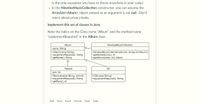
Concept explainers
Inheritance, Polymorphism, ArrayLists, Throwing Exceptions
The UML diagram below shows a set of classes designed to represent a music collection from 1995. The constructors and methods all function in the standard way, except:
The equipmentRequired method should return “Record Player” or “CD Player” as appropriate.
The getAlbum method of the NinetiesMusicCollection class accepts an index and returns the corresponding Album object. This method throws an IllegalArgumentException if the index is out of range. (This is the only exception you have to throw anywhere in your code.)
In the NinetiesMusicCollection constructor, you can assume the ArrayList<Album> object passed as an argument is not null . Don’t worry about privacy leaks.
Implement this set of classes in Java.
Note the italics on the Class name “Album” and the method name “equipmentRequired” in the Album class.

Trending nowThis is a popular solution!
Step by stepSolved in 2 steps

- Instructions-Java Assignment is to define a class named Address. The Address class will have three private instance variables: an int named street_number a String named street_name and a String named state. Write three constructors for the Address class: an empty constructor (no input parameters) that initializes the three instance variables with default values of your choice, a constructor that takes the street values as input but defaults the state to "Arizona", and a constructor that takes all three pieces of information as input Next create a driver class named Main.java. Put public static void main here and test out your class by creating three instances of Address, one using each of the constructors. You can choose the particular address values that are used. I recommend you make them up and do not use actual addresses. Run your code to make sure it works. Next add the following public methods to the Address class and test them from main as you go: Write getters and…arrow_forwardThe class definition for an Item is given in the image UML diagram below Note: getInfo() returns a string containing ALL of the state information neatly organized. Part 1: Create a class based on the specification above. Reminder: – means private and + means public. Part 2: a)Write a function/method called “addItem” that takes: An array of items The number of items in the array An integer representing a barcode A string representing the name of an item A string representing the description of an item A double value representing the price The function must create and add the item to the array if there is space. The function must return “true” if the addition was successful and “false” otherwise. b)Write a function/method called “listItems” that takes: An array of items The number of items in the array The function must return a string containing the information on each item in the array. c)Write a function called “pricelookup” that takes : An array of items The number of…arrow_forwardarray of Payroll ObjectsDesign a PayRoll class that has data members for an employee’shourly pay rate and number of hours worked. Write a program withan array of seven PayRoll objects. The program should read thenumber of hours each employee worked and their hourly pay ratefrom a file and call class functions to store this information in theappropriate objects. It should then call a class function, once foreach object, to return the employee’s gross pay, so this informationcan be displayed.arrow_forward
 Database System ConceptsComputer ScienceISBN:9780078022159Author:Abraham Silberschatz Professor, Henry F. Korth, S. SudarshanPublisher:McGraw-Hill Education
Database System ConceptsComputer ScienceISBN:9780078022159Author:Abraham Silberschatz Professor, Henry F. Korth, S. SudarshanPublisher:McGraw-Hill Education Starting Out with Python (4th Edition)Computer ScienceISBN:9780134444321Author:Tony GaddisPublisher:PEARSON
Starting Out with Python (4th Edition)Computer ScienceISBN:9780134444321Author:Tony GaddisPublisher:PEARSON Digital Fundamentals (11th Edition)Computer ScienceISBN:9780132737968Author:Thomas L. FloydPublisher:PEARSON
Digital Fundamentals (11th Edition)Computer ScienceISBN:9780132737968Author:Thomas L. FloydPublisher:PEARSON C How to Program (8th Edition)Computer ScienceISBN:9780133976892Author:Paul J. Deitel, Harvey DeitelPublisher:PEARSON
C How to Program (8th Edition)Computer ScienceISBN:9780133976892Author:Paul J. Deitel, Harvey DeitelPublisher:PEARSON Database Systems: Design, Implementation, & Manag...Computer ScienceISBN:9781337627900Author:Carlos Coronel, Steven MorrisPublisher:Cengage Learning
Database Systems: Design, Implementation, & Manag...Computer ScienceISBN:9781337627900Author:Carlos Coronel, Steven MorrisPublisher:Cengage Learning Programmable Logic ControllersComputer ScienceISBN:9780073373843Author:Frank D. PetruzellaPublisher:McGraw-Hill Education
Programmable Logic ControllersComputer ScienceISBN:9780073373843Author:Frank D. PetruzellaPublisher:McGraw-Hill Education





